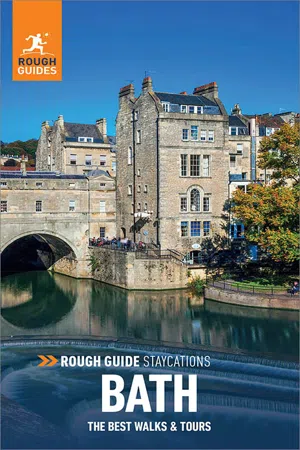
- 128 pages
- English
- ePUB (mobile friendly)
- Available on iOS & Android
Rough Guide Staycations Bath (Travel Guide eBook)
About This Book
Rough Guides Staycations Bath Make the most of your time on Earth with the ultimate travel guides. Inspirational and informative new pocket guide, making the most of holidaying at home in the UK through clearly laid-out walks and tours. Explore the best of Bath with this unique travel guide, packed full of insider information and stunning images. From making sure you don't miss out on must-see, top attractions like The Royal Crescent, Roman Baths and Milsom Street to discovering cultural gems, including Bath Abbey, such as The Jane Austen festival and stunning Georgian architecture, the easy-to-follow, ready-made walking and driving routes will save you time, and help you plan and enhance your staycation in Bath. Features of this travel guide to Bath:
- 10 walks and tours: detailed itineraries feature all the best places to visit, including where to eat along the way
- Local highlights: discover the area's top sights and unique attractions, and be inspired by stunning imagery
- Time-saving itineraries: carefully planned routes will help inspire and inform your on-the-road experiences
- Historical and cultural insights: learn more about Bath's rich history with fascinating cultural insights throughout
- Insider recommendations: where to stay and what to do, from active pursuits to themed trips
- Rainy day recommendations: uncover plenty of options, whatever the weather throws at you
- Practical full-colour maps: with every major sight and listing highlighted, the full-colour maps make on-the-ground navigation easy
- Key tips and essential information: from transport to hours of operation, we've got you covered
- New for 2021: the latest guidance to all the places you should discover in Bath- Covers: The ancient centre and a modern spa; Georgian grandeur (The Upper Town); Across Pulteney Bridge; The spine of the city; From Pulteney Bridge to Prior Park; Bath and the countryside in film; Bristol; Wells and Glastonbury; Longleat and Stourhead; The ancient sites (Stonehenge and Avebury).
Looking for a comprehensive guide to England? Check out Rough Guides England for a detailed and entertaining look at all the country has to offer.
About Rough Guides: Rough Guides have been inspiring travellers for over 35 years, with over 30 million copies sold. Synonymous with practical travel tips, quality writing and a trustworthy 'tell it like it is' ethos, the Rough Guides list includes more than 260 travel guides to 120+ destinations, gift-books and phrasebooks.
Frequently asked questions
Information




Table of contents
- 10 Things not to miss
- Introduction to Bath
- Festivals in Bath
- Tour 1: The ancient centre and a modern spa
- Tour 2: Georgian grandeur (The Upper Town)
- Feature: Architectural Bath
- Tour 3: Across Pulteney Bridge
- Tour 4: The spine of the city
- Feature: Bath as a spa
- Tour 5: From Pulteney Bridge to Prior Park
- Tour 6: Bath and the countryside in film
- Feature: Literary Bath
- Tour 7: Bristol
- Tour 8: Wells and Glastonbury
- Tour 9: Longleat and Stourhead
- Tour 10: The ancient sites (Stonehenge and Avebury)
- Active Pursuits
- Themed Holidays
- Practical Information
- Accommodation